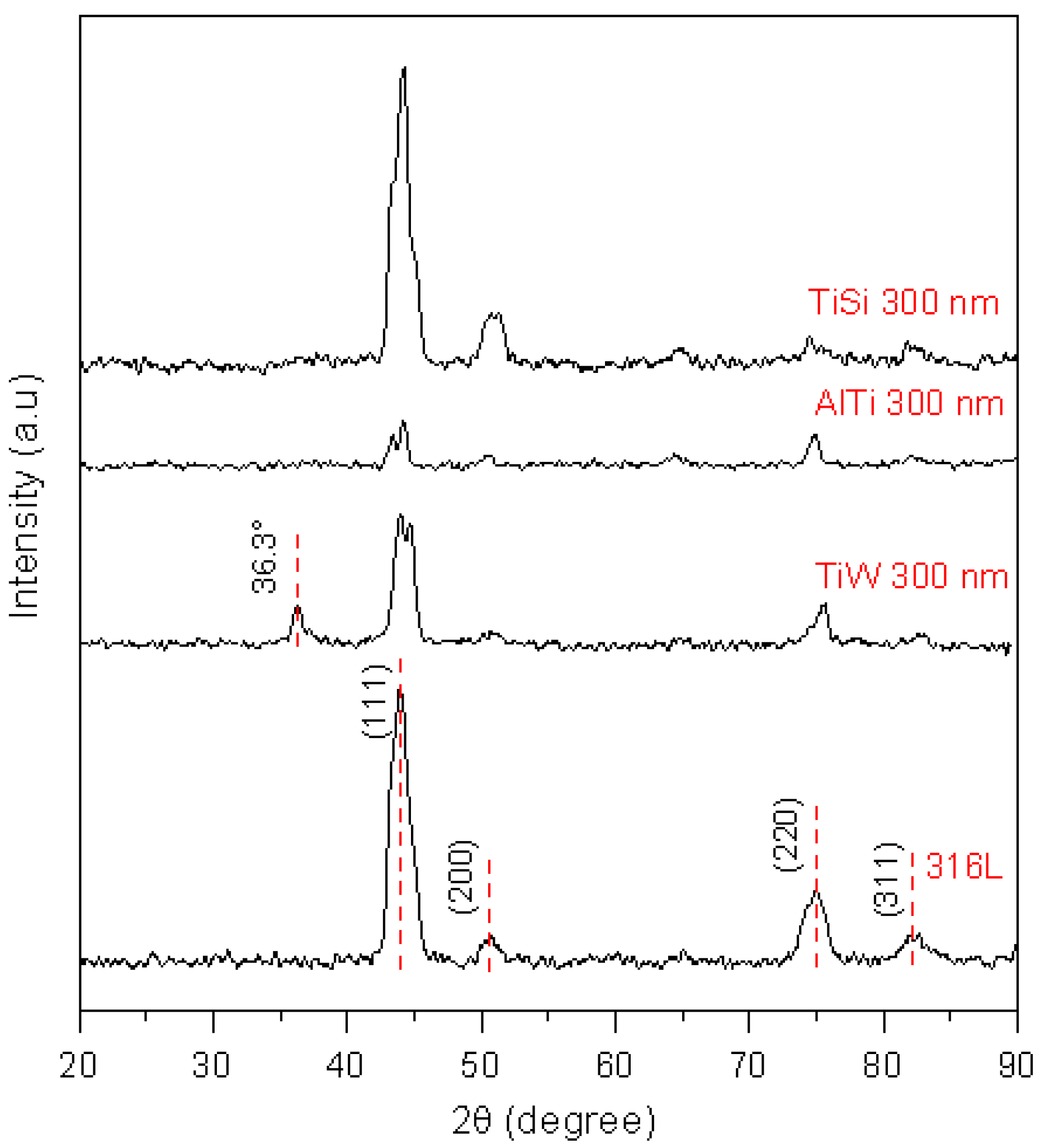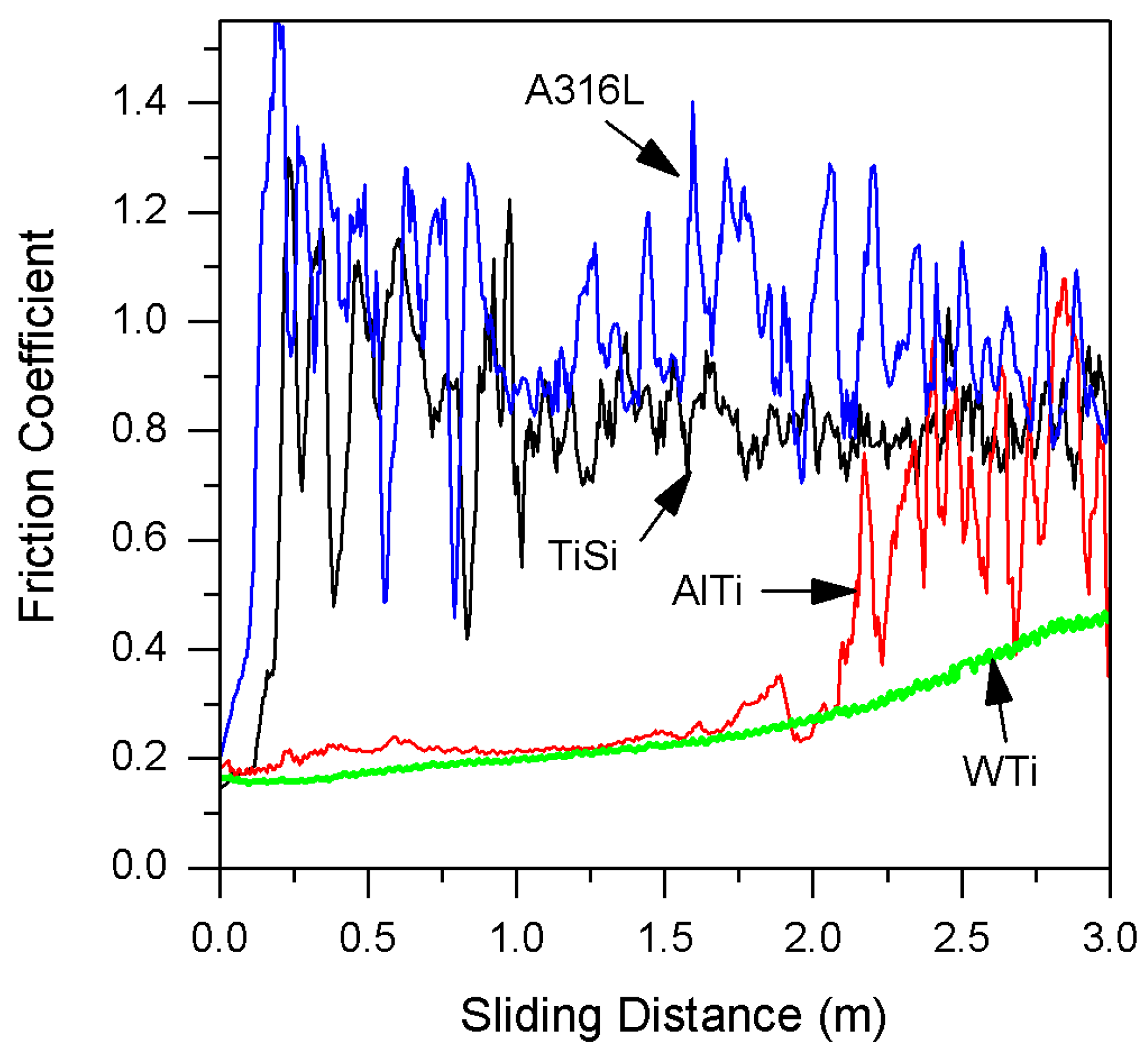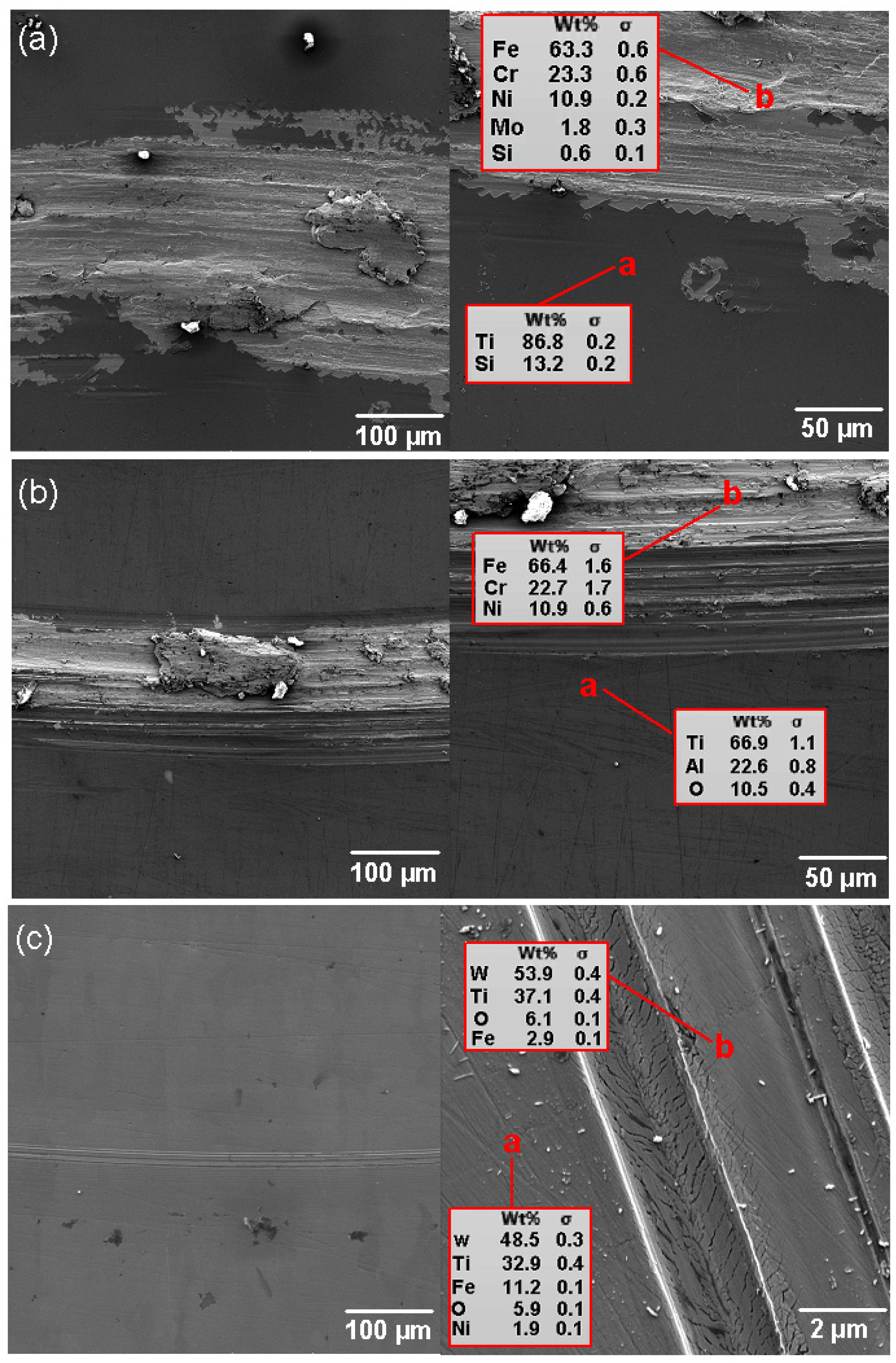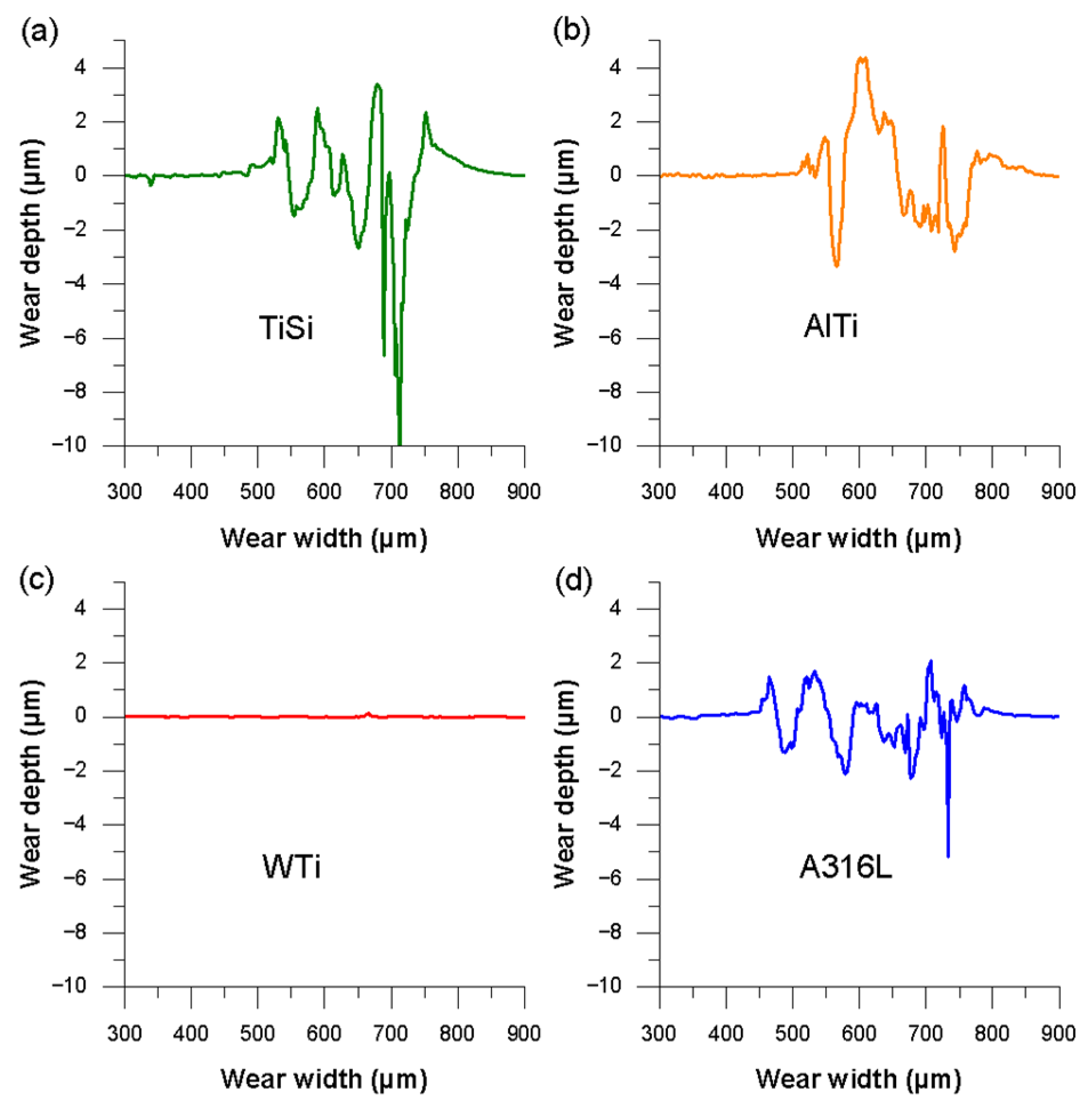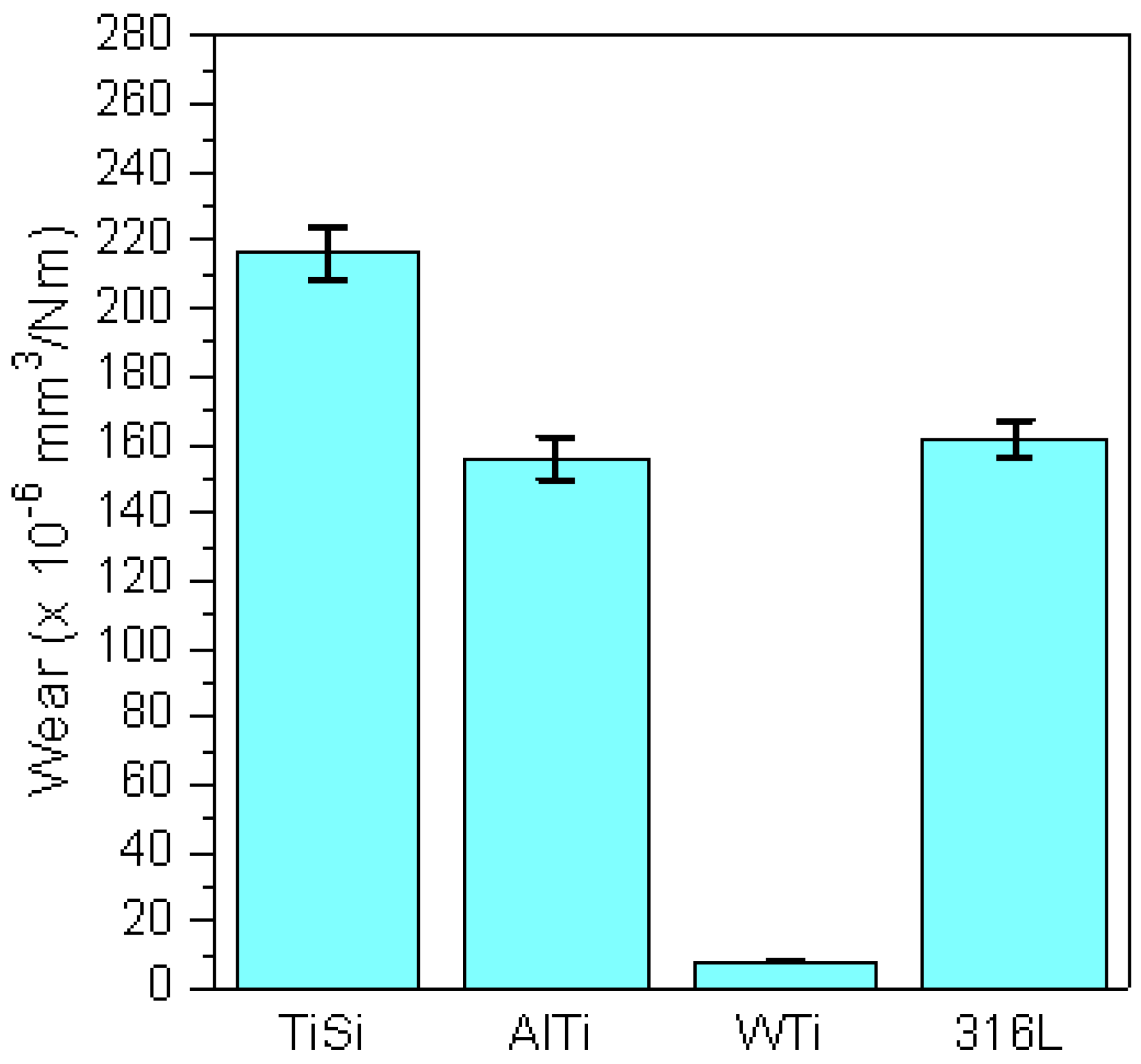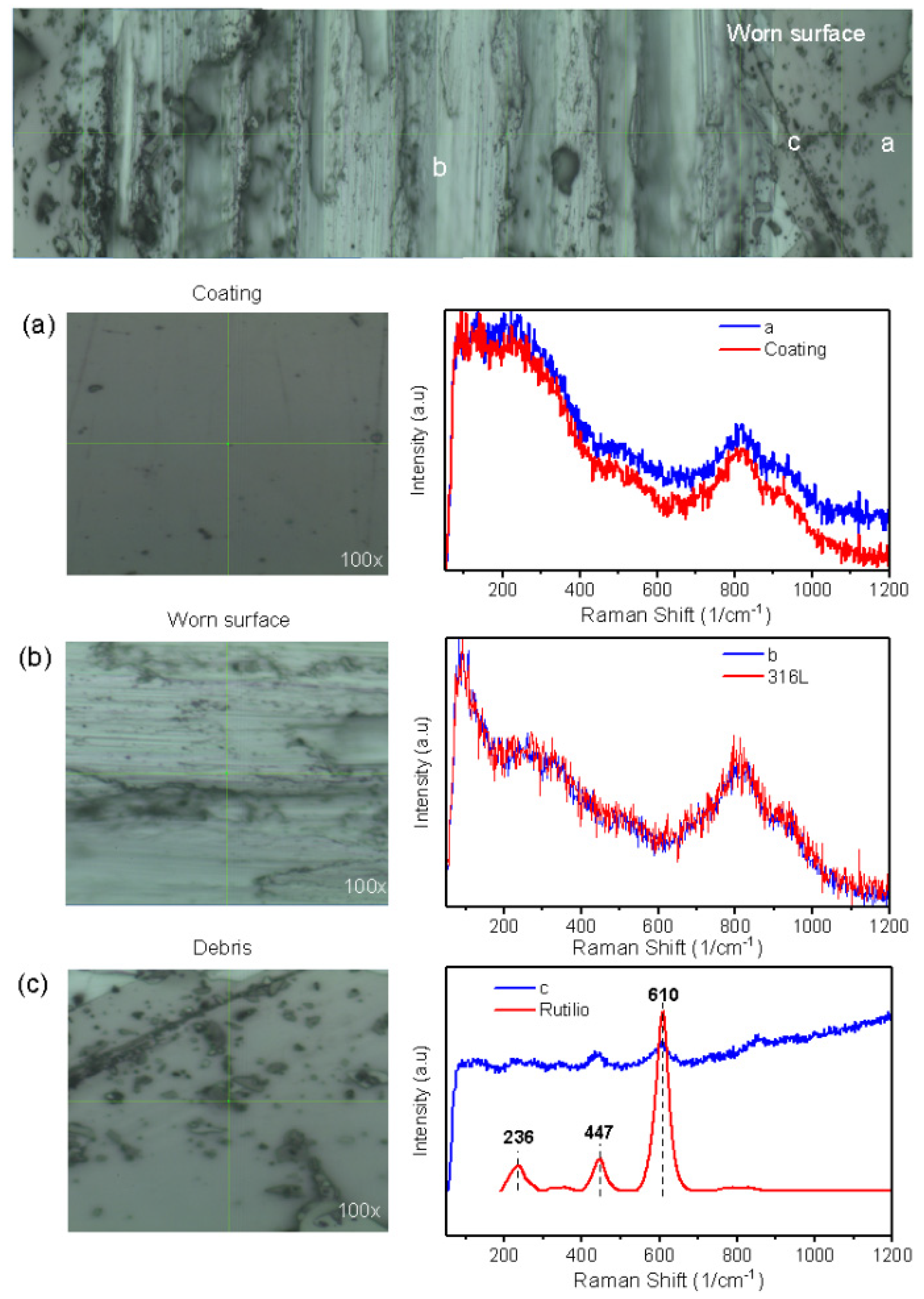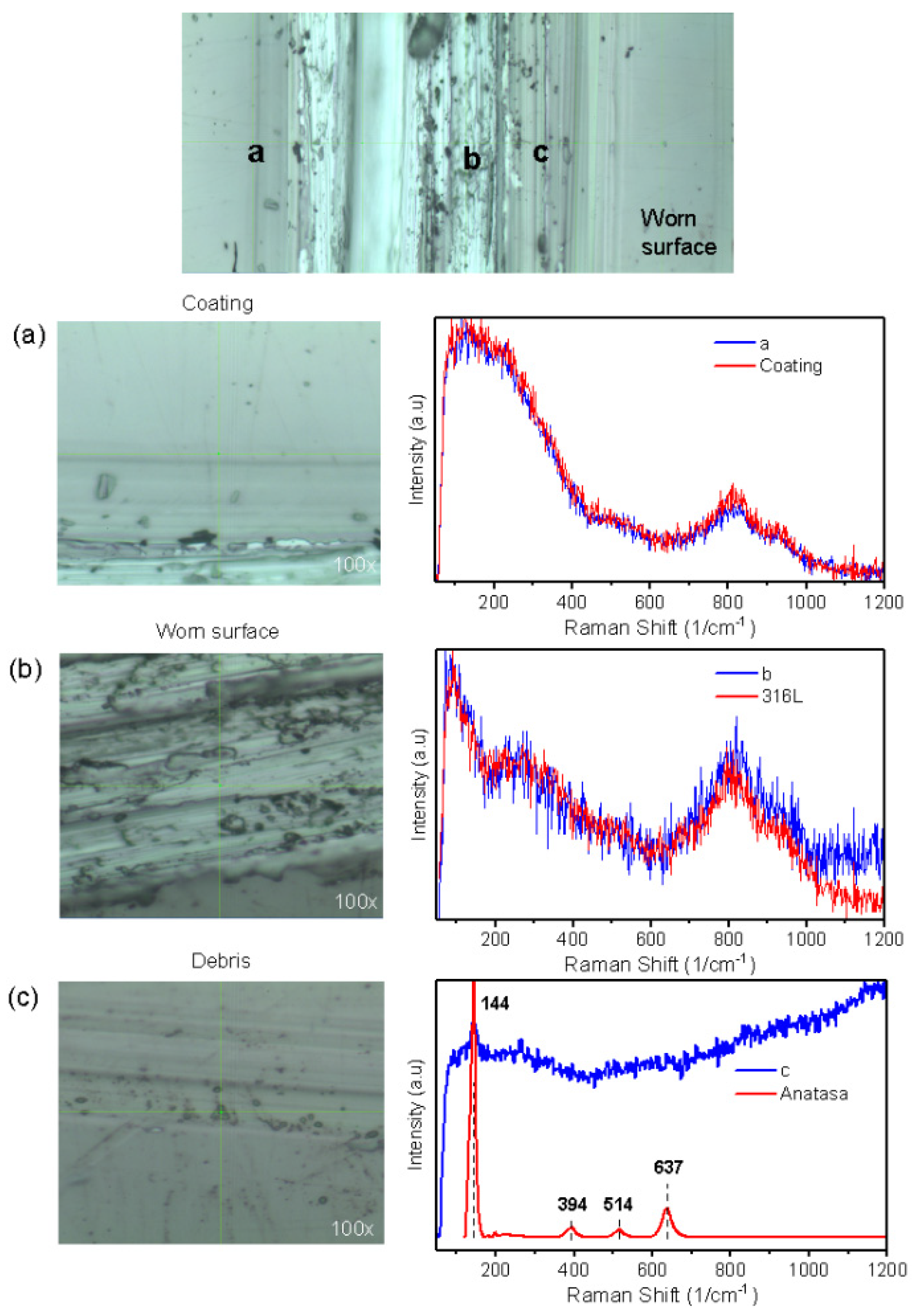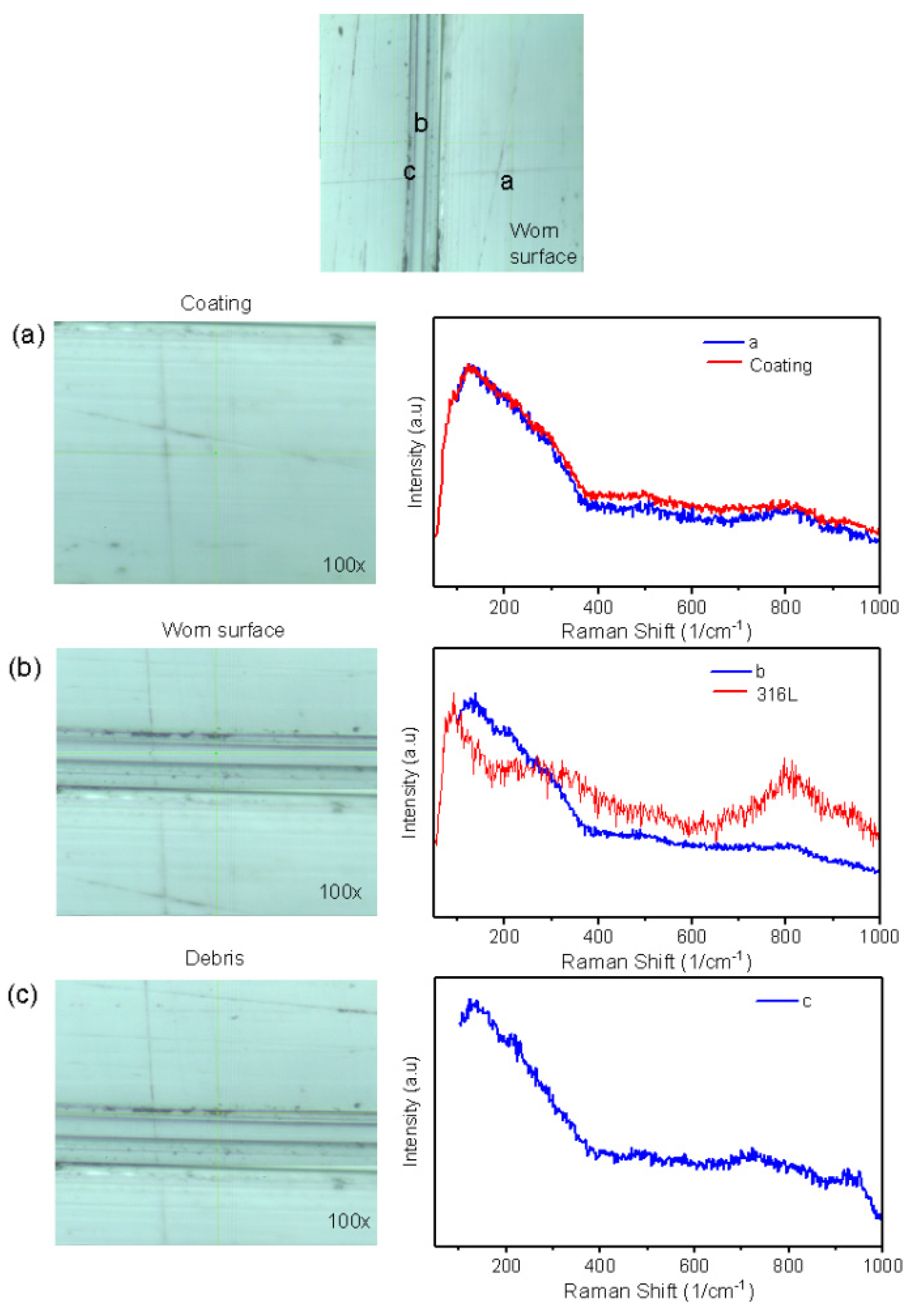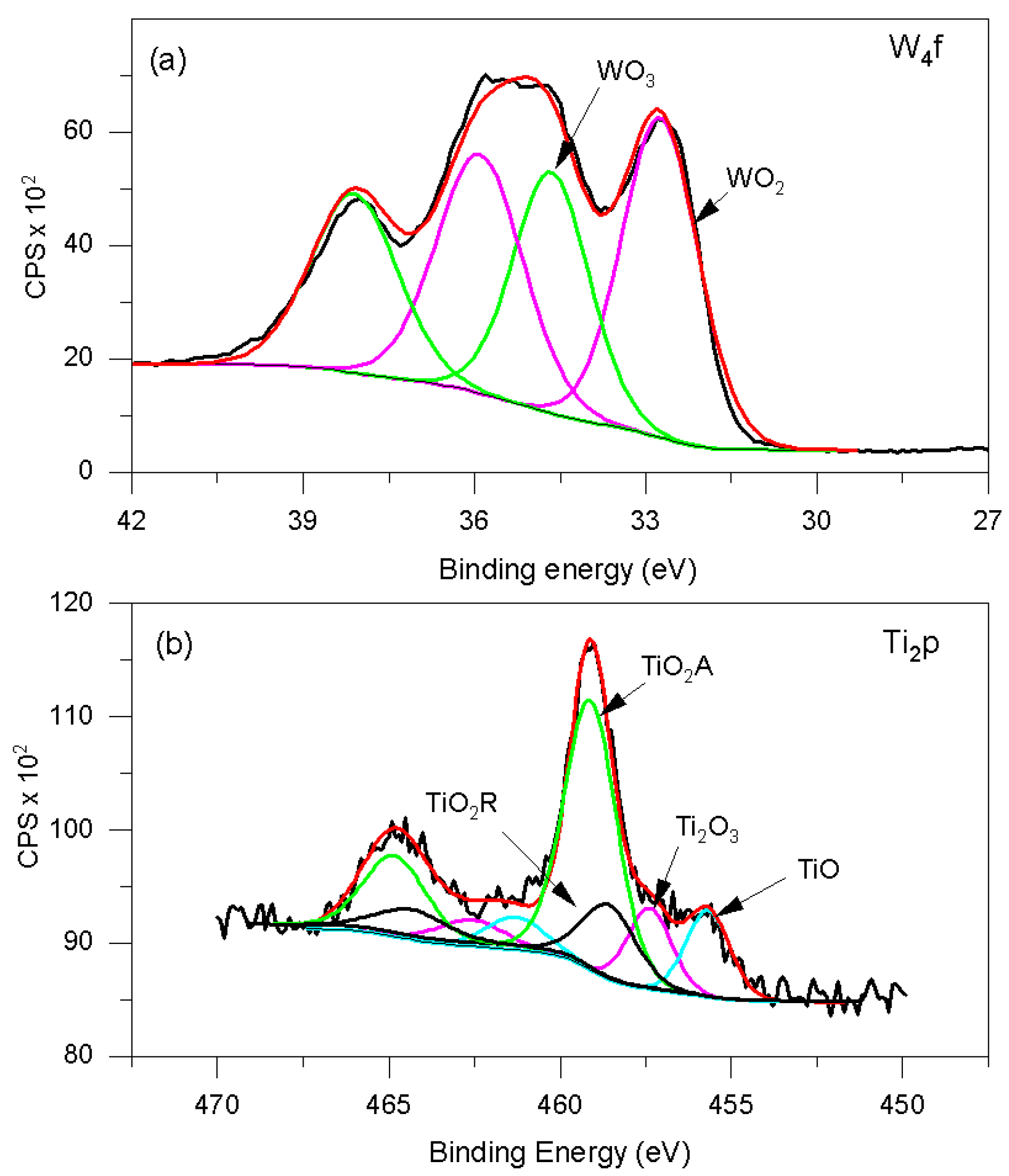1. Introduction
AISI 316L austenitic stainless steel is widely used for high-temperature applications, as well as in highly corrosive conditions and in nuclear reactor applications. However, despite its great advantages, its low hardness (200 HV), and the fact that it has an austenitic structure that cannot be hardened by heat treatment means, there is no easy way to improve its wear resistance [
1].
Physical vapor deposition (PVD) has attracted considerable interest in recent years since it allows for the deposition of dense and compact coatings, leading to better chemical and mechanical properties. This technique produces a wide range of coatings with high wear and corrosion resistance at relatively low cost and is synthesized through relatively simple processes [
2]. The PVD process has several advantages since it allows for the selection of the alloy constituents for binary or ternary compositions with controlled concentrations and high purity, which can be deposited on different kinds of substrates [
3]. The system of deposition by radio frequency (RF) magnetron sputtering is included into the PVD processes, which allows for a wide variation of deposition parameters that affect the structural and morphological characteristics of the films deposited and, consequently, their properties. For example, it produces a high-density plasma, allowing one to use insulating targets and achieve coatings with physical properties useful for different industrial applications.
Titanium-based non-ferrous metal alloys are characterized by being lightweight, with high mechanical strength, toughness, malleability, and ductility. Properly alloyed titanium can reach a mechanical resistance up to 1400 MPa with improved tribological and anticorrosive properties and can be used in heat exchangers, pipes, reactors, pumps, and valves in the chemical, naval, and petrochemical industries or in various parts for applications in the biomedical or aeronautical sector. The addition of Al alloying elements in titanium alloys favors the hexagonal close-packed structure (HCP) and the growth of intermetallic compounds. Aluminum is undoubtedly the most important and effective alloying element for improving the high-temperature oxidation resistance of titanium and its alloys. At high temperatures, sufficient aluminum can be selectively oxidized into a stable, compact, and continuous layer of aluminum oxide (Al
2O
3) called alumina. With this oxide, the diffusion of titanium and oxygen can be effectively retarded, and therefore the resistance to corrosion at high temperatures for this type of material can be improved [
4].
The W in Ti alloys stabilizes the face-centered cubic (BCC) structure and increases the mechanical strength and the response to heat treatment. WTi coatings have many important properties from a technological point of view, such as their electrical resistance, thermal stability, oxidation resistance, chemical stability, and good adhesion to the substrate. For these reasons, WTi coatings have been studied as anticorrosive protection and for use in oxidation-resistant coatings [
5]. TiW thin films can be used as a diffusion barrier for the WTi coating, and its applicability largely depends on the concentration of titanium. The most frequently used stoichiometry is W:Ti (90:10%), where tungsten is used as a diffusion barrier because the atomic diffusivity of most metals in tungsten is low and it avoids diffusion through grain boundaries [
5,
6].
Si in titanium alloys is neutral, due to its four valence electrons. TiSi coatings exhibit numerous attractive properties for industrial applications, such as excellent oxidation and wear resistance, a high degree of hardness, low relative density, and a high melting point. From the viewpoint of stable oxide formation on the TiSi coating surface, it should be mentioned that two types of oxides can be formed simultaneously on the surface exposed to air: titanium oxide (TiO
2) and silicon oxide (SiO
2). SiO
2 can provide higher corrosion resistance than can the formation of TiO
2 [
7].
Coatings based on Ti, Si, W, and Al synthesized by different techniques have been investigated in order to better understand their wear and oxidation behavior [
8,
9,
10,
11,
12,
13]. Research shows that the oxides formed from Si, Al, and W help counteract the negative effects of titanium oxide by forming oxides that are stable and adherent to the surface of the coating, leading to improved wear resistance and durability and resistance to oxidation at high temperatures in these systems [
14,
15,
16]. PVD and CVD techniques allow one to synthesize materials with these components at reasonable production costs, allowing materials with good tribological and electrochemical properties to be applied in different industrial sectors. These metallic alloys, in the form of a thin film deposited by means of the sputtering process, open up an important field of new materials with nanostructured or amorphous grain size and adequate values of thermal expansion coefficients, and in addition there is sufficient diffusion and chemical affinity to ferrous surfaces to be used as a buffer interlayer in order to improve the adhesion and wear resistance of hard or ceramic coatings deposited on ferrous metal substrates.
According to the literature, there is no research related to the synthesis of Ti-Si, Al-Ti, and W-Ti thin films and the evaluation of their tribological properties. The objective of this study is to investigate the behavior of AlTi, TiSi, and WTi coatings in a ball-on-disc wear test when they are deposited using the PVD technique on an AISI 316 stainless steel substrate, enabling a study of the wear indicators (coefficient of friction and wear rate) and an analysis of the products that are formed during the wear.
2. Materials and Methods
The coatings were deposited using the RF magnetron sputtering technique with Alcatel type HS 2000 commercial equipment, which is described in previous papers [
17]. For the development of this investigation, three titanium alloy coatings were used, with the following three targets: W90/Ti10, Al50/Ti50, and Ti81/Si19, with 99.99% purity. Square samples 10 mm per side and 4 mm thick of AISI 316L stainless steel were used as substrates. Before starting the deposition of the coatings, the samples were metallographically polished and subjected to ultrasonic cleaning for 20 min. The coatings’ deposition parameters were the following: room temperature, source power of 200 W, frequency of 13.65 MHz, initial pressure of 5.6 × 10
−4 Pa, and working pressure of 4.6 × 10
−2 Pa, with an argon flow of 20 sccm. The distance from the target to the substrate was 10 cm.
Table 1 summarizes the deposition conditions used to synthesize the coatings.
The coatings were produced by controlling the times of discharge, and the thicknesses of films were measured with a Dektak 150 model Veeco mechanical profilometer, with a resolution of 10 nm (Dektak 150, Veeco UK, St. Ives, UK). A curve of deposition rates and thickness vs. discharge time was elaborated for each binary alloy, as shown in
Figure 1. These curves were used to determine the times of discharge of the system for obtaining coatings of approximately 300 nm thickness. In general, deposition rates of ~20 nm/min for the TiSi coating, 22 nm/min for the AlTi coating, and ~16 nm/min for the TiW coating were used.
The morphology of the coatings was determined by means of scanning electron microscopy (SEM), using a TESCAN/MIRA 3 (Tescan Mira 3, Tescan, Brno, The Czech Republic) microscope operating in secondary and backscattered electron mode with a voltage between 4 and 15 kV. An Oxford Instruments X-MAX 50 X-ray detector (EDS) (Oxford Instruments, Abingdon, UK) coupled to the microscope was used to determine the elemental composition of the coatings. Scanning electron microscopy was also used to observe the surface morphology of the samples after being subjected to wear tests. The microstructural analysis of the samples was performed on an Xpert Pro diffractometer (Panalytical, Almelo, The Netherlands). The diffractograms were obtained at room temperature, operating with monochromatic copper Kα line (1.540998 Å) at 45 kV and 40 mA. An analysis of the diffractograms was carried out using X’pert Hi Score Plus software (version 3.0.5, PANalytical B.V., Almelo, The Netherlands).
The hardness of the coatings was determined using an HVS 1000A microhardness tester (HVS-1000A, Laizhou Huayin Instrument Co., Ltd., Laizhou, China) with a load of 10 g and a time of load application of 30 s. Six hardness measurements were taken per sample. The surface roughness of the samples was measured using a Bruker Contour Gt-k profilometer (Bruker Contour GTK, Bruker Nano Surfaces Division, Tucson, AZ, USA).
Substrate samples and coated samples were subjected to ball-on-disc adhesive wear tests. The tests were performed on a CSM tribometer (CSM, Graz, Austria) under a normal load of 1 N at a linear speed of 16 cm/s for 3 m final displacement, using a 316L stainless steel ball 4 mm in diameter. The tests were carried out under atmospheric conditions with a relative humidity of 60% at a room temperature of 27 °C. The friction coefficient was quantified by the tribometer, and the wear rate of the coatings was calculated according to the following equation [
18]:
where V is the wear volume in mm
3, which is calculated from the cross-section area of the wear track, F is the normal load in newtons, and S is the sliding distance in m. The geometry of the wear tracks was determined with the Bruker Contour Gt-k profilometer (Bruker Contour GTK, Bruker Nano Surfaces Division, Tucson, AZ, USA). The wear track morphology was analyzed via scanning electron microscopy using a TESCAN/MIRA 3 microscope (Tescan Mira 3, Tescan, Brno, The Czech Republic). The (EDS) X-MAX 50 (Oxford Instruments, Abingdon, UK) probe on the microscope allowed for the elemental composition analysis of the wear track area.
Raman spectroscopy was used to identify the wear products on the coatings [
19]. A LabRam HR Evolution de Jobin Yvon Horiba Scientific spectrometer (Horiba Jobin Yvon, Piscataway, NJ, USA) equipped with an Olympus BX41 microscope was used. An excitation wavelength of 514.5 nm belonging to the argon laser was used, performing a spectrum analysis between 100 cm
−1 and 1200 cm
−1. Measurements were made with a 100× objective lens with an acquisition time of 30 s and double-time accumulation. The identification of the corrosion and wear products was established through reference spectra obtained from the RRUFF database and research articles on oxidation and wear [
20,
21].
The wear track of the WTi coating was analyzed using the X-ray photoelectron spectroscopy technique (XPS). The equipment used was a Kratos Axis Ultra under ultra-high-vacuum system (Kratos. Analytical, Manchester, UK), with a base pressure of about 9–10 torr. A monochromatic X-ray Al source was used, at 1486.5 eV and 150 W, with a source of 15 kV. The emitted photoelectrons were collected in a hemispherical analyzer with a spatial resolution of 15 μm. The energy resolution of the equipment was 0.58 eV. A scan of each of the samples was performed in survey mode, followed by localized scans in the W4f and Ti2p regions, corresponding to the locations of the tungsten and titanium peaks. CasaXPS software (Casa Software Ltd., Wilmslow, Cheshire, UK) was used for signal processing.
3. Results and Discussion
Figure 2 shows the micrographs of the different TiSi, AlTi, and WTi coatings on 316L steel substrates obtained by means of scanning electron microscopy in secondary electron mode. Smooth, homogeneous surfaces were seen, with the presence of few defects, which, in accordance with the deposition conditions, correspond to a T-type microstructure, according to the Thorton model [
22]. The chemical characterization of the surface obtained by means of the EDS technique is shown in the inserts of the image. The presence of titanium was determined at 86.4% by weight in the TiSi coating, followed by 22.5% in the AlTi coating and 20.9% in the WTi coating.
In general terms, the chemical composition varied with respect to that reported in the targets: titanium-silicon (Ti)80(Si)20, aluminum-titanium (Al)50(Ti)50, and titanium-tungsten (Ti)10(W)90. This is explained by Jacobs and collaborators [
23], who say that the ratio of yields is directly related to the ratio of deposition rates. The “sputtering yields” of the pure elements used with an energy of 500 eV and with Ar ions are Al = 1.05, Si = 0.5, Ti = 0.51, and W = 0.57 [
24,
25]. Using these values, the relationship between the “yields” of the different elements with Ti would be as follows: Si/Ti = 0.98, Al/Ti = 2.05, and W/Ti = 1.1. These results favor a higher deposition of Al from the AlTi target, and a higher deposition rate of Ti for the SiTi target and of W for the TiW target [
23]. In some cases, where the elements that make up the target have significantly different masses, coatings with a different composition than the target can be obtained. In this case, the atomic masses of the elements are Al = 26.9815 UMAS, Si = 28.0855 UMAS, Ti = 47.867 UMAS, and W = 183.84 UMAS. In addition, a number of factors can influence the nucleation of the deposited layers, where the structure of the substrate surface is of critical importance, including the grain size, defect density, texture, roughness, and composition of the substrate’s surface [
24].
Figure 3 shows the diffractograms of the three coatings and the substrate. The TiSi and AlTi coatings deposited on the 316L stainless steel were identified as amorphous. Four peaks can be seen in these diffractograms at the 2θ angles: 43.9°, 50.7°, 74.9°, and 90.8°, corresponding to the planes (111), (200), (220), and (311) of 316L stainless steel, according to JCPD letter 00-031-0619. In general, the diffractograms of the TiSi films show that there is no defined crystalline structure. This is possibly due to the fact that several alloys become amorphous over a wide compositional range with the sputtering technique, as reported by Bhattara et al. [
26] and Zhao et al. [
27] in their research associated with the growth of TiSiOx films by means of sputtering on silicon and copper substrates. This was done with a powdered target and a mixture of argon and oxygen. X-ray diffraction results showed that the films grew amorphously. In the diffractograms of the TiAl films, the characteristic peaks are not perceptible, and consequently the phases in the films cannot be identified, so this coating also grew amorphously. These results are consistent with the investigations by Zhang et al. [
28], who sputtered TiAl coatings and reshaped their amorphous structure. They explain that this behavior is due to the fact that the formation of critical nuclei is difficult in TiAl. Additionally, the temperature at the beginning of the sputtering process is close to room temperature. This low temperature reduces atomic mobility, which also makes it difficult for TiAl to crystallize. The reason for this behavior is directly related to the Gibbs free energy since at low temperatures they observed that the Gibbs energy of the amorphous phase approaches that of other disordered solution phases. Therefore, if the nucleation of the crystalline phase is suppressed, the amorphous phase will appear at low temperatures [
29].
For the WTi coating, the four characteristic peaks of the 316L steel substrate were identified. Two signals were found at 2θ angles: 36.30° and 44°, which correspond to the rutile phase of titanium oxide (JCDP21-1276), planes (101) and (210). These results are consistent with the research by Wang and Liang [
30]. Bhaga et al. [
31] reported similar results. They used the JCPDS 04-0806 and JCPDS 44-1294 charts.
Table 2 shows the results for microhardness and roughness measured in the samples. The microhardness values for the TiSi and WTi coatings show a reduction in hardness relative to the substrate’s hardness, while the AlTi coating shows an increase in hardness. It is important to keep in mind that the microhardness values reported in
Table 1 represent the combined hardness of the coating-substrate system because of an important effect of the mechanical properties of the substrate, due to the thickness of the coating (300 nm approx.) and the loads used in the test. The roughness measurements show that the coatings reduced the irregularities of the substrates. The roughness was reduced on average to one-third of the initial roughness.
Figure 4 shows the results for the friction coefficients determined in the ball-on-disc adhesive wear test. In this figure, the coefficient of friction of the substrate can be seen as a reference line (blue). The TiSi coating exhibits a rapid increase in the coefficient of friction and reaches the same level of coefficient of friction as the substrate in a short test run (20 cm), a response that allows one to infer possible severe damage from the coating. The wear mechanisms present during this test may be associated with adhesive and oxidative wear. For instance, Chang [
32] used a tribometer to evaluate the tribological performance of the TiSi coating, and the coefficient of friction exhibited a gradual increase from the start to an unstable state between 0.5 and 0.75. This type of behavior is affected by the tribochemical reactions [
33], which often occur in most ceramics.
In the test of the AlTi coating, the coefficient of friction was reduced to a value one-fifth that of the coefficient of friction of the substrate and increased slowly until reaching a path of 1.5 m. When this path had arisen, the coefficient of friction increased until reaching 0.8, showing severe damage to the coating under these test conditions, which favor wear mechanisms by adhesion, abrasion, and oxidation. These results agree well with those found by Hamid [
34] in wear studies on Al-Ti base alloys, who describe that the coefficient of friction increases during the initial slip stage and then fluctuates around 0.7 with additional slip.
The WTi coating exhibited a significant reduction of the coefficient of friction, with a minimum value of 0.17 at the beginning of the test and a slow and continuous growth up to a value of 0.4 at the end of the run. COF values even lower than those reported in the literature were obtained. For example, Silva and his collaborators [
35] obtained COF values in the range of 0.45 to 0.6, reaching even lower values of μ with steel. The presence of solid lubricants, such as oxides and porosities, in the compounds could be responsible for the observed decrease in the coefficient of friction for this material throughout the test.
Figure 5 shows micrographs of the wear traces on the (a) TiSi, (b) AlTi, and (c) WTi coatings. The micrograph of the TiSi coating allows one to observe a wear trace that penetrates to the substrate, breaking the coating, as shown in
Figure 5a. The accumulation of fragments of material that adhered to the interior of the footprint, sections of unremoved coating and plastic, and deformations of the substrate in the form of grooves, perhaps due to the increase in temperature during the tribological contact, can be seen. The same characteristics of the wear trace can also be seen in the AlTi coating but with the difference that its wear track is narrower (see
Figure 5b). The WTi coating exhibited lower degradation against wear, its wear footprint was the smallest compared to the other coatings, it did not present any breakage of the coating, little grooves and deformations and microcracks were observed, and it had a much smaller wear track width than the other coatings.
Figure 6 and
Figure 7 show the topography of the wear marks measured by profilometry. The images clearly show the accumulation of material on the wear track in the TiSi and AlTi coatings. Deep grooves along the sliding direction of these coatings can also be seen, confirming what was seen in the SEM images. This figure shows how, at the same scale as the 3D profile (0.95 mm × 126 mm), the wear track of the WTi coating is visually almost imperceptible, and thanks to the detail shown, the trace left by this coating can be observed, which has a much smaller footprint. It can be seen in
Figure 6a,b that the wear patterns on the surface of the 316L substrate are similar in morphology for the TiSi and AlTi coatings.
Figure 7 shows that for AlTi and TiSi coatings, the depth of the trace exceeds the thickness of the coatings, corroborating the severe damage to them. On the other hand, a remarkable performance of the WTi coating against wear in the ball-on-disc test can be noted, where, thanks to its tribological properties, it does not reach the substrate, managing to reach the end of the test without appreciable failure. The results of the profilometry analysis are presented in
Table 3, which summarizes the large wear track widths and depths that correspond to the breakage of the coating in the TiSi and AlTi cases. There are also low values of width (22 µm) and depth of indentation (0.03 µm), showing the good performance of the WTi coating. The wear rates were calculated using the values presented in
Table 2, and the values obtained are shown in
Figure 8. It can be seen that the wear rate values obtained for the AlTi coating are comparable to those of the substrate, while in the case of the TiSi coating, it exhibits a 35% increase in the wear rate, this being an undesirable behavior in a protective coating. The WTi coating has a wear rate of 4% of that of the substrate, a value that exemplifies the favorable behavior of this coating as a projecting element of the substrate under conditions of wear. The study of the morphology of the imprint allows us to conclude that the TiSi and AlTi coatings do not provide adequate protection for the 316L substrate against wear, while the WTi coating reduces the coefficient of friction and the rate of wear.
The results of the EDS analysis in
Figure 5 corresponding to the TiSi coating show the composition of point “a” with elements Fe, Cr, Ni, Mo, and Si, which correspond to the substrate, while point “b” is composed of elements such as Ti and Si of the coating, confirming the catastrophic damage of the coating. There is no evidence to indicate the presence of oxygen on the wear track. The image shows the existence of islands of coating on the wear track of the 316 ball’s passage over the surface of the coating. These observations were confirmed via EDS analysis, in addition to measurements made on the wear track that showed the presence of substrate detached and adhered to the generated trace.
Figure 5a shows a small piece of detached substrate (approximately 100 µm) adhering to the wear track. The results of the EDS analysis on the wear track in the AlTi coating for the points marked as “a” and “b” are presented in
Figure 5b. The EDS analysis shows not only the presence of Fe, Cr, and Ni on the wear track but also elements such as Ti, Al, and O, which would confirm the presence of the substrate and the oxidized coating on the wear track. The adhesion of particles from the premature failure of the coating can be seen, as well as large particulates on it. In the case of the WTi coating, they showed the presence of W, Ti, and O, as well as the presence of Fe and Ni on the wear track and debris, as shown in
Figure 5c. The image reveals the existence of particles smaller than 2 µm and of agglomerated material on the wear track left by the ball, as well as the finding of microcracks, especially on the grooves left by the tribological contact product, as a consequence of the plastic deformation suffered by the WTi coating. The integrity of the coating suggests that the stainless steel components on the indentation correspond to wear debris from the test ball.
The Raman spectra for the wear trace and the debris in the TiSi coating can be seen in
Figure 9. In
Figure 9a, the spectrum obtained at point a, next to the wear trace, can be seen, and it was found that the measured spectrum corresponds to the reference spectrum of the coating, showing that there was no chemical transformation (oxidation) of the coating at points close to the wear track. In
Figure 9b, it can be seen that the spectrum obtained is similar to the Raman spectrum of the 316L substrate, corroborating that the wear trace reached the substrate, which reveals the failure of the TiSi coating. The optical microscopy image of the wear track,
Figure 9c, allows us to see how the debris (wear products) accumulated on both sides of the wear track; this debris is mainly formed by very small and partially oxidized coating fragments, as can be seen in the Raman spectrum of point c, which shows vibration modes corresponding to the rutile phase of TiO
2 titanium oxide [
36,
37,
38].
Figure 10 shows the Raman spectra of the wear trace and the debris of the AlTi coating.
Figure 10a shows the Raman spectra of the points marked (a) and (b) inside and outside the trace. The spectrum of point (a) shows similarity with the spectrum taken for the AlTi coating, while the spectrum of point (b) shows similarity with the spectrum of the substrate. This analysis clearly shows the excessive wear in the center of the footprint and therefore the absence of the AlTi coating.
Figure 10c shows the debris generated by the tribological contact, and the Raman spectrum of point (c) shows a transformation of the coating to the anatase phase of titanium oxide (TiO
2) [
36,
37,
38].
Figure 11 shows the Raman spectra obtained for the points marked as (a) coating, (b) wear track, and (c) debris. The spectra obtained show the same Raman spectrum as that taken for the coating, indicating, according to the Raman spectroscopy, that there was no appreciable chemical transformation of the debris and the wear trace.
As a consequence of the damage results for the TiSi and AlTi coatings, the XPS analysis was only performed on the wear trace of the WTi coating.
Figure 12 shows the XPS spectra for tungsten W4f and titanium Ti2p for the wear track of the WTi coating. For the worn surface, the W4f 7/2 of the WTi coating was mainly characterized by binding energies of 35.8 eV for the WO
3 oxide and 32.8 eV for the WO
2 oxide [
39]. The Ti2p spectrum for the worn surface of the WTi coating is shown in
Figure 12b. Ti2p3/2 was found to be mainly characterized by binding energies of 455.5, 457.3, 459.11, and 458.55, which have usually been associated with the presence of the oxides TiO, Ti
2O
3, and TiO
2 in the anatase and rutile phases, respectively [
36,
37,
38,
40]. This indicates that at least within the depth of detection of XPS (3–5 nm), the surface of this coating was oxidized during the wear process of the ball-on-disc test. The highest intensity of the peaks was exhibited by the tungsten oxide WO
2, followed by the WO
3 and at lower intensity the anatase phase of titanium oxide TiO
2, followed by the rutile phase, and ending with the oxides Ti
2O
3 and TiO, respectively. From the XPS analysis, we wish to point out that five different types of oxides were found on the surface of the coating, three of titanium and two of tungsten (see
Figure 12), which formed layers of less than 5 nm, which could be the cause of the good performance of the coating on the ball-on-disc test. After the discovery of oxygen on the surface of the coating through the EDS technique and the detection of chemical compounds through the XPS technique, it is worth pointing out that the Raman technique failed to find oxides such as WO
3 or the anatase and rutile phases of TiO
2 oxide because the WO
2 layer, which would cover the surface, is not visible by Raman. The presence of tungsten oxides identified by XPS corroborates the improvement in the tribological conditions of the surface since it is recognized that tungsten oxide has an influence in a low coefficient of friction [
41].


